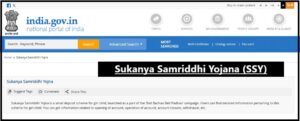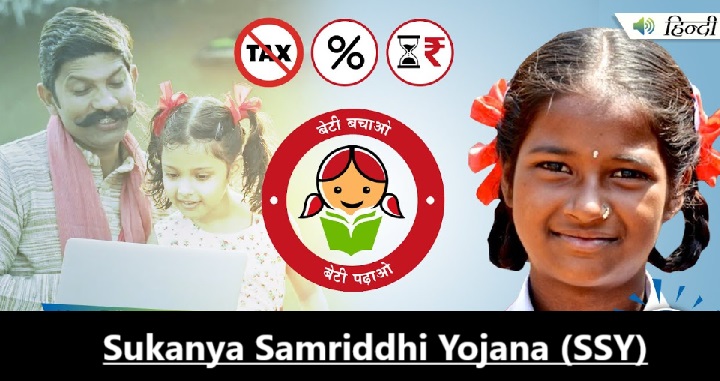Introduction to Sukanya Samriddhi Yojana (SSY)
The Sukanya Samriddhi Yojana (SSY) is a transformative government-backed savings initiative in India, specifically tailored to secure the financial future of girl children. Launched in January 2015 as a part of the Beti Bachao Beti Padhao campaign, SSY was created with the dual objectives of promoting the education of girls and ensuring their economic empowerment. This scheme encourages parents to save for the education and marriage expenses of their daughters by offering attractive interest rates, tax benefits, and guaranteed returns. The program has quickly gained popularity among Indian families who view it as a vital tool for fostering gender equality and securing their daughters’ futures.
One of the standout features of the SSY is its competitive Sukanya Samriddhi Yojana Interest Rate, which is set by the government and reviewed quarterly. This rate is often higher than traditional savings accounts, making it an appealing option for long-term savings. Additionally, the tax benefits associated with the scheme further enhance its attractiveness, allowing parents to claim deductions on contributions under Section 80C of the Income Tax Act. As a result, not only does SSY help families accumulate wealth over time, but it also provides financial incentives for saving specifically for girls.
In essence, SSY serves as a comprehensive financial product that empowers families to take proactive steps towards ensuring the well-being of their daughters. By promoting a culture of saving and investing in education, this scheme plays a pivotal role in changing societal perceptions and fostering a supportive environment for girl children in India.
Also Check – PM Awas Yojana Urban 2.0 List 2024
Why Was Sukanya Samriddhi Yojana Introduced?
The introduction of the Sukanya Samriddhi Yojana is a strategic response to India’s persistent issues concerning gender inequality and declining child sex ratios. For many years, the societal bias towards sons has led to financial, social, and emotional challenges for families with daughters. The Beti Bachao Beti Padhao campaign aims to combat these entrenched biases by emphasizing the importance of protecting and promoting the education of girls. Within this context, the SSY was developed to serve as a supportive financial mechanism for families, thereby alleviating the perceived financial burden of raising a girl child.
By providing a dedicated savings platform that offers guaranteed returns, SSY encourages parents to view their daughters as valuable assets rather than financial liabilities. The scheme aims to shift societal attitudes by illustrating the potential benefits of investing in girls’ education and future. Through this initiative, the government hopes to inspire families to recognize the importance of girls in contributing to society and the economy, ultimately working towards achieving gender parity.
Moreover, SSY addresses practical financial concerns by assisting families in accumulating funds for significant milestones such as education and marriage. This financial security is crucial in a society where education is paramount for a girl’s empowerment and career prospects. By reducing the financial stress associated with these life events, SSY not only fosters a culture of saving but also aims to uplift the status of girls in society, thereby contributing to broader social change.
Also Read – Pradhan Mantri Fasal Bima Yojana (PMFBY) 2024
Full Details Of Sukanya Samriddhi Yojana (SSY)
| Feature | Details |
|---|---|
| Eligibility | Girl child below 10 years of age |
| Account Opening | By parent/guardian, up to 2 accounts per family (except in case of twins/triplets) |
| Minimum Deposit | ₹250 per year |
| Maximum Deposit | ₹1.5 lakh per year |
| Deposit Frequency | Annually, in multiples of ₹50 |
| Maturity Period | 21 years from account opening or on girl child’s marriage after 18 years |
| Partial Withdrawal | Allowed for educational purposes after 18 years (up to 50% of balance) |
| Interest Rate | 7.6% (2023) – revised quarterly by government |
| Premature Closure | Allowed in case of death, severe illness, or if the girl becomes an NRI |
| Tax Benefits | Deposits, interest, and maturity amount are tax-free under Section 80C |
| Transferable | Between banks and post offices, free of cost if relocating |
| Penalty for Non-Deposit | ₹50 per year along with minimum deposit to reactivate account |
Sukanya Samriddhi Yojana Interest Rate 2024
The interest rate for Sukanya Samriddhi Yojana (SSY) is reviewed quarterly by the government. For the second quarter of the financial year 2024-2025 (July to September 2024), the interest rate is set at 8.2% per annum. This interest rate is compounded annually, making the SSY one of the highest interest-bearing small savings schemes in India. This competitive interest rate ensures that the savings grow substantially over the years, securing the future of the girl child.
Sukanya Samriddhi Yojana Interest Rate 2024:
- Current Interest Rate: 8.2% p.a. (July – September 2024)
- Compounding: Annually
- Historical Interest Rates: The interest rate has ranged between 7.6% to 8.5% over the past few years.
- No Interest After Maturity: No interest accrues after the completion of the account’s tenure, which is 21 years.
Interest Rates of Sukanya Samriddhi Yojana (SSY) Over the Years
| Financial Year | Interest Rate (%) | Remarks |
|---|---|---|
| 2020-2021 | 7.6% | Compounded Annually |
| 2019-2020 | 8.4% | Revised Quarterly |
| 2018-2019 | 8.5% | Government Revised Rate |
| 2017-2018 | 8.1% | Competitive Interest Rate |
| 2016-2017 | 8.6% | Market-Driven Changes |
| 2015-2016 | 9.2% | Early Years of the Scheme |
| 2014-2015 | 9.1% | Initial Rate When Scheme Launched |
Sukanya Samriddhi Yojana Benefits
The SSY scheme comes with a range of benefits that make it an attractive option for families looking to secure their daughter’s financial future.
- Low Minimum Deposit: One of the major advantages of the Sukanya Samriddhi Yojana is the flexibility it offers in terms of deposits. The minimum annual deposit required is only ₹250, making it affordable for families from all economic backgrounds. However, the maximum deposit is capped at ₹1.5 lakh per year.
- High Interest Rate: The SSY interest rate is currently 8.2%, which is higher than many other savings schemes. The compounded annual interest rate ensures that the corpus grows significantly over time.
- Tax Benefits: Sukanya Samriddhi Yojana offers excellent tax benefits under Section 80C of the Income Tax Act. Deposits up to ₹1.5 lakh are eligible for tax deductions, and both the interest earned and the maturity amount are tax-free.
- Long Tenure: The scheme has a tenure of 21 years or until the girl child’s marriage after the age of 18, whichever comes earlier. This long tenure ensures substantial accumulation of funds.
- Guaranteed Returns: As a government-backed scheme, Sukanya Samriddhi Yojana guarantees returns, ensuring financial security for the girl child upon maturity.
- Educational and Marriage Expenses: The SSY allows partial withdrawals (up to 50% of the balance) for the education or marriage expenses of the girl child once she reaches 18 years of age.
- Easy Transfers: The account can be easily transferred from one bank or post office to another, making it convenient for families that move frequently.
Sukanya Samriddhi Yojana Eligibility 2024
To open an SSY account, certain eligibility criteria must be met:
- Parents or Guardians: Only the parents or legal guardians of a girl child can open the account.
- Age Limit: The Sukanya Samriddhi Yojana age limit for 2024 is that the girl child must be under 10 years of age at the time of account opening. This ensures that parents start saving for their child’s future early on.
- Residency Status: The girl child must be an Indian resident. Non-resident Indians (NRIs) are not eligible to open an SSY account.
- One Account per Girl Child: Only one account can be opened per girl child. However, a family can open two SSY accounts if they have more than one daughter.
- Special Provision for Twins/Triplets: In the case of twins or triplets, more than two accounts can be opened.

How to Open a Sukanya Samriddhi Yojana Account
Opening a Sukanya Samriddhi Yojana Savings Account is simple and can be done at any participating bank or post office. Here’s how to go about it:
- Visit a Participating Bank or Post Office: SSY accounts can be opened at most public sector banks and post offices across India. Some of the major banks include State Bank of India, Punjab National Bank, and ICICI Bank.
- Fill Out the Application Form: You will need to fill out an application form and provide supporting documents, including the girl child’s birth certificate, proof of address, and identity proof of the guardian.
- Make the First Deposit: The initial deposit can range from ₹250 to ₹1.5 lakh. This deposit can be made via cash, cheque, or demand draft.
- Receive the Passbook: Once the account is opened, you will receive a passbook that contains details of the account, deposits, and interest earned.
Sukanya Samriddhi Yojana Withdrawal Rules
The SSY allows for both partial and full withdrawals, subject to certain conditions:
- Partial Withdrawal: A partial withdrawal of up to 50% of the balance is allowed once the girl child reaches 18 years of age. This can be used for higher education or marriage expenses. To withdraw, you will need to submit proof of the girl’s admission to an educational institution or provide documents related to her marriage.
- Full Withdrawal on Maturity: The SSY account matures after 21 years from the date of opening or upon the marriage of the girl child after she turns 18. At this point, the full balance, including interest, can be withdrawn.
- Premature Closure: Premature closure of the SSY account is allowed in certain cases, such as the death of the account holder or if the girl child becomes a non-resident.
Sukanya Samriddhi Yojana Age Limit 2024
As mentioned, the Sukanya Samriddhi Yojana Age Limit for 2024 specifies that the girl child must be under 10 years of age at the time of account opening. This rule ensures that parents start saving early for their daughter’s future. It is advisable to open the SSY account as soon as possible after the birth of the girl child to maximize the benefits of the scheme.
Also Read – NTR Vidyonnathi Scheme 2024
How to Calculate Sukanya Samriddhi Yojana Interest
The interest for the Sukanya Samriddhi Yojana Calculator account is calculated based on the lowest balance in the account between the 5th day and the last day of each month. The accumulated interest is then credited to the account once a year, at the end of the financial year.
To estimate the interest earned on an SSY account, you can use the following formula:
A = P(1+r/n)^(nt)
Where:
- P = Initial deposit or principal amount
- r = Annual interest rate
- n = Number of times interest is compounded annually
- t = Number of years the account is active
- A = Final maturity amount
Since the interest on an SSY account is compounded annually, calculating it manually can be complex. Instead, you can use a Sukanya Samriddhi Yojana Calculator, which simplifies the process by generating the maturity amount. Simply enter details such as the expected annual investment, the age of the girl child, and the account’s starting year.
Sukanya Samriddhi Yojana Tax Benefits 2024
One of the most attractive features of the Sukanya Samriddhi Yojana Tax Benifits:
- Section 80C Deductions: Contributions made to the SSY account are eligible for tax deductions under Section 80C of the Income Tax Act, up to a maximum of ₹1.5 lakh per financial year.
- Tax-Free Interest: The interest earned on the SSY account is entirely tax-free under Section 10 of the Income Tax Act. This makes the scheme more lucrative than other savings instruments where interest is taxable.
- Tax-Free Maturity Amount: The maturity amount, which includes both the principal and the interest, is completely tax-free. This ensures that the returns from the SSY account are maximized, without any deductions at maturity.
Sukanya Samriddhi Yojana Online Payment
With the increasing digitization of financial services, making payments to the Sukanya Samriddhi Yojana account has become easier. You can now make online payments through the India Post Payments Bank (IPPB) mobile app, ensuring that you never miss a payment. Simply link your SSY account with the app, transfer funds from your bank, and set up automatic payments if desired.
How to Transfer a Sukanya Samriddhi Account from the Post Office to a Bank
To transfer a Sukanya Samriddhi Yojana (SSY) account from a post office to a bank, follow these steps:
- Visit the Post Office (PO): The guardian can visit the post office where the account is currently held. The girl child is not required to be present.
- Inform the PO Executive: Notify the post office executive of your intent to transfer the SSY account.
- Submit Required Documents: Provide the completed account transfer form and KYC documents. The post office executive will verify the documents and initiate the transfer process.
- Visit the Bank: After the transfer process is completed, visit the bank branch where you wish to maintain the SSY account.
- Submit Documents to the Bank: Provide the bank with self-attested KYC documents and any other paperwork from the post office.
- Receive New Passbook: Once the bank processes the request, a new passbook will be issued for the SSY account.
The SSY account can be transferred anywhere in India between post offices and banks without any charge, provided there is proof of a change in the residence of the guardian or the girl child. For transfers under other circumstances, a fee of ₹100 will be charged.

Sukanya Samriddhi Yojana vs Public Provident Fund (PPF)
Both Sukanya Samriddhi Yojana (SSY) and Public Provident Fund (PPF) are government-backed schemes, but they serve different purposes:
- PPF: Primarily a retirement savings scheme, it can be opened by any individual.
- SSY: Designed specifically for the financial security of a girl child, an SSY account can only be opened for girls under 10 years of age.
Sukanya Samriddhi Yojana vs LIC
The Life Insurance Corporation (LIC) offers life insurance products, including the LIC Kanyadan policy, which can be compared to the Sukanya Samriddhi Yojana (SSY) in terms of providing financial security for a girl child. Both schemes aim to support the future expenses of education and marriage for a girl child.
However, there are key differences between the two:
- SSY Access: The girl child can access the funds in an SSY account once she turns 18.
- LIC Kanyadan Access: In contrast, the LIC Kanyadan policy does not allow direct access to the girl child. The benefits are primarily available only after the father’s death, as it is a life insurance policy designed to support the girl’s future in the event of the father’s passing.
Also Check – PM Kisan 18th Installment 2024
FAQs for Sukanya Samriddhi Yojana (SSY)
- Who is eligible to open an SSY account?
The parents or legal guardians of a girl child below 10 years of age can open an SSY account. Each family can open up to two accounts, except in the case of twins or triplets. - What are the minimum and maximum deposit limits for SSY?
The minimum deposit is ₹250 per year, and the maximum is ₹1.5 lakh annually. Deposits can be made in multiples of ₹50. - How does the maturity period of SSY work?
The SSY account matures after 21 years from the date of opening or upon the girl child’s marriage after the age of 18, whichever is earlier. - Is partial withdrawal allowed before the maturity of the SSY account?
Yes, partial withdrawals of up to 50% are allowed for educational purposes when the girl child reaches 18 years of age. - How is the interest rate for SSY determined?
The interest rate is set by the government and reviewed every quarter. It is usually higher than other small savings schemes, currently around 7.6%, and is compounded annually. - What happens if I don’t deposit the minimum required amount in a year?
The account becomes inactive, but it can be revived by paying a penalty of ₹50 per default year along with the minimum deposit of ₹250. - Can SSY accounts be transferred between banks and post offices?
Yes, SSY accounts can be transferred between banks or between a bank and a post office anywhere in India. Transfers are free of charge if due to relocation. - What is the difference between SSY and LIC Kanyadan?
SSY is a small savings scheme aimed at girl child development, while LIC Kanyadan is a life insurance product. SSY allows withdrawals for education and marriage, whereas LIC Kanyadan only provides benefits after the father’s death. - Are there any tax benefits on deposits made in SSY?
Yes, deposits in SSY are eligible for tax deductions under Section 80C of the Income Tax Act. The interest earned and the maturity amount are also tax-free. - Can the SSY account be closed prematurely?
Premature closure is allowed under specific circumstances, such as the death of the account holder, serious illness, or if the girl child becomes a Non-Resident Indian (NRI).

